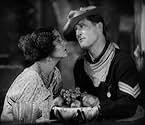IMDb RATING
5.5/10
1.3K
YOUR RATING
A charming, happy-go-lucky bandit in old Arizona plays cat-and-mouse with the sheriff trying to catch him while he romances a local beauty.A charming, happy-go-lucky bandit in old Arizona plays cat-and-mouse with the sheriff trying to catch him while he romances a local beauty.A charming, happy-go-lucky bandit in old Arizona plays cat-and-mouse with the sheriff trying to catch him while he romances a local beauty.
- Won 1 Oscar
- 4 wins & 4 nominations total
Henry Armetta
- Barber
- (uncredited)
James Bradbury Jr.
- Soldier
- (uncredited)
Frank Campeau
- Man Chasing Cisco
- (uncredited)
John Webb Dillion
- Second Soldier
- (uncredited)
Alphonse Ethier
- Sheriff
- (uncredited)
Jim Farley
- Townsman
- (uncredited)
William Gillis
- Guard
- (uncredited)
Pat Hartigan
- Cowpuncher
- (uncredited)
Soledad Jiménez
- Tonita the Cook
- (uncredited)
Ivan Linow
- Russian Immigrant
- (uncredited)
Tom London
- Man in Saloon
- (uncredited)
Helen Lynch
- Stagecoach Passenger
- (uncredited)
J. Farrell MacDonald
- Stage Passenger
- (uncredited)
Julius Viggo Madsen
- Tenor in Quartet
- (uncredited)
Storyline
Did you know
- TriviaThe first all-talking, sound-on-film feature shot outdoors.
- GoofsWhen Cisco robs the stagecoach, he is wearing an army holster (flap-over), the same type the Sergeant wears. But for the rest of the movie, he wears an open holster.
- Quotes
[last lines]
The Cisco Kid: Her flirting days are over. And she's ready to settle down.
- ConnectionsFeatured in The Soundman (1950)
- SoundtracksMy Tonia
Words and Music by Buddy G. DeSylva (as DeSylva), Lew Brown (as Brown) and Ray Henderson (as Henderson)
Sung by Warner Baxter (uncredited)
Featured review
"In Old Arizona" was made in 1928 at a time when sound was still a novelty in films. As such you can see in this film sequences that purely demonstrate sound but add nothing to the story. For example, in the opening scene after the stagecoach leaves, the camera moves to a mariachi band that appears out of nowhere to play a song, and later a scene begins with a quartet warbling a little ditty before moving over to the principle characters.
The story centers on the Cisco Kid (Warner Baxter) who is a likable rogue who robs stagecoaches (but not the passengers) and has a price on his head of $5,000. It seems that everyone knows the kid on sight except the town barber. His girlfriend Tonia Maria (Dorothy Burgess) is an obvious pre-production code prostitute, who "entertains" him when he is not robbing stagecoaches.
The army is asked to do something about all of the robberies. They send Sgt. Mickey Dunn (Edmund Lowe) to investigate. Along the way he meets Tonia Maria who seduces him (off screen of course) and the two plot to capture the Kid and claim the reward. Naturally the Kid uncovers the plot and prepares a surprise for the sergeant and his unfaithful girlfriend.
This film is rather dated when watched today. It is over talkative and has just awful acting in many of the supporting roles, particularly the actor who plays the stagecoach driver. But you have to remember that this was the first year of sound movies. Director Raoul Walsh used outdoor microphones for the first time in a major studio production. You'll notice a few "silent spots" in the out door scenes.
The three leads are OK but the Mexican "accents" of Baxter and Burgess are laughable. Actually as hard to believe as it was, Baxter won the 1929 Academy Award for his role. Walsh was supposed to play the Lowe part but lost an eye in an accident about this time.
J. Farrell MacDonald appears early in the film as an Irish stagecoach passenger.
The story centers on the Cisco Kid (Warner Baxter) who is a likable rogue who robs stagecoaches (but not the passengers) and has a price on his head of $5,000. It seems that everyone knows the kid on sight except the town barber. His girlfriend Tonia Maria (Dorothy Burgess) is an obvious pre-production code prostitute, who "entertains" him when he is not robbing stagecoaches.
The army is asked to do something about all of the robberies. They send Sgt. Mickey Dunn (Edmund Lowe) to investigate. Along the way he meets Tonia Maria who seduces him (off screen of course) and the two plot to capture the Kid and claim the reward. Naturally the Kid uncovers the plot and prepares a surprise for the sergeant and his unfaithful girlfriend.
This film is rather dated when watched today. It is over talkative and has just awful acting in many of the supporting roles, particularly the actor who plays the stagecoach driver. But you have to remember that this was the first year of sound movies. Director Raoul Walsh used outdoor microphones for the first time in a major studio production. You'll notice a few "silent spots" in the out door scenes.
The three leads are OK but the Mexican "accents" of Baxter and Burgess are laughable. Actually as hard to believe as it was, Baxter won the 1929 Academy Award for his role. Walsh was supposed to play the Lowe part but lost an eye in an accident about this time.
J. Farrell MacDonald appears early in the film as an Irish stagecoach passenger.
- bsmith5552
- Jun 1, 2005
- Permalink
- How long is In Old Arizona?Powered by Alexa
Details
Box office
- Gross US & Canada
- $2,834,000
- Runtime1 hour 35 minutes
- Color
Contribute to this page
Suggest an edit or add missing content


































